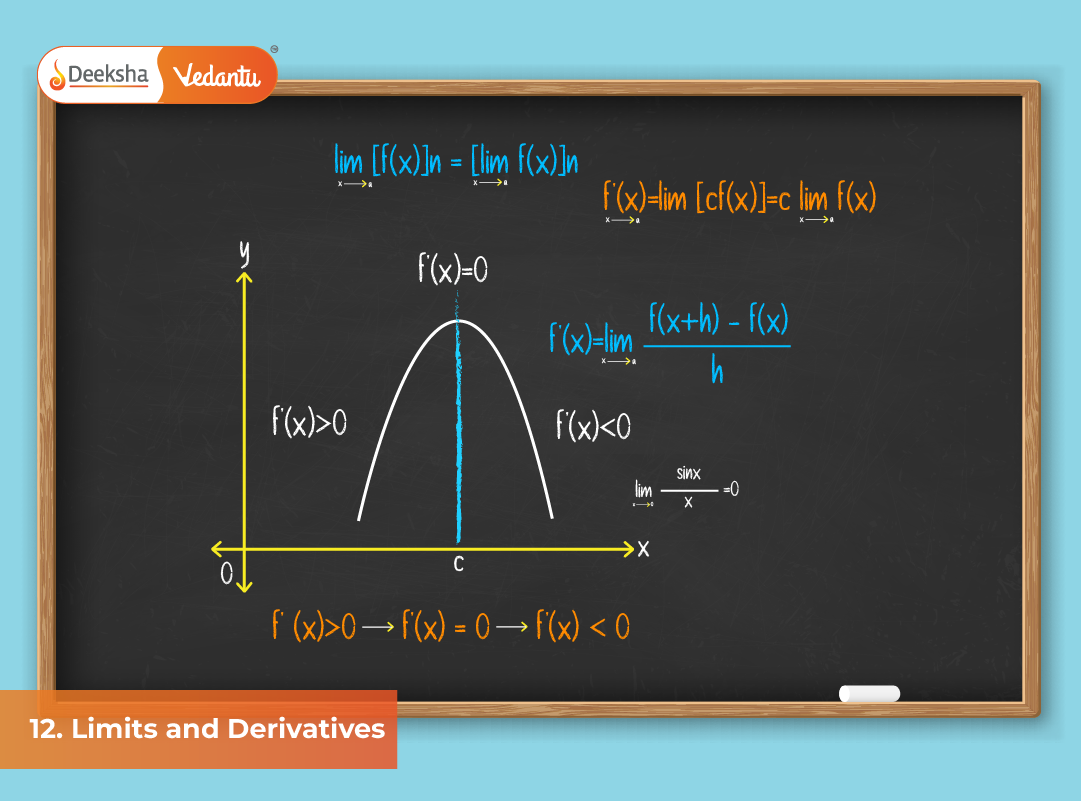
Introduction
Calculus begins here! The chapter Limits and Derivatives introduces you to one of the most powerful ideas in mathematics – how functions behave near certain points and how fast they change. These concepts might sound abstract at first, but they form the foundation of almost every major topic in JEE Maths, from Continuity and Differentiability to Integral Calculus and Application of Derivatives.
Understanding this chapter doesn’t just help in Maths – it also sharpens your problem-solving skills in Physics, especially in topics like motion, kinematics, and dynamics. By the end of this chapter, you’ll have a strong grasp of how to find the slope of a curve, calculate instantaneous rates of change, and apply limits to simplify complex expressions.
Marks Weightage in JEE
| Exam | Approx. Weightage | Average Questions | Difficulty Level |
| JEE Main | 6–8 marks | 2 questions | Moderate |
| JEE Advanced | 8–10 marks | 2–3 questions | Moderate to Difficult |
Every year, around 2 to 3 questions from this chapter or its extended concepts (like continuity or basic calculus applications) appear in both JEE Main and JEE Advanced. It’s one of those topics where conceptual understanding is more valuable than memorization.
Why This Chapter Matters for JEE
- It lays the foundation for Differentiation and Integration, which together account for over 20% of the JEE Maths paper.
- Concepts from this chapter appear in Mathematics, Physics, and sometimes Chemistry (Rate of Reaction) problems.
- Questions are a mix of conceptual theory and formula-based numericals.
- Mastery of limits and derivatives improves logical reasoning and precision – key skills for tackling advanced problems.
Overview of Subtopics
Let’s briefly go through what each section of Chapter 12 covers before we dive deeper into them individually.
12.2 Intuitive Idea of Derivatives
This section helps you understand the concept of a derivative – the rate at which one quantity changes with respect to another. Using simple motion examples, you’ll learn how the slope of a tangent line on a graph represents the rate of change. This sets the stage for formal differentiation in later chapters.
12.3 Limits
Limits form the foundation of calculus. This subtopic teaches how functions behave when inputs get close to specific values. You’ll learn to handle indeterminate forms like 0/0 and ∞/∞, using algebraic simplification and standard results.
12.4 Limits of Trigonometric Functions
Here you explore special limit cases involving trigonometric functions like sin, cos, and tan. You’ll encounter formulas such as lim (x→0) sinx/x = 1 and their applications in simplifying trigonometric expressions.
12.5 Derivatives
This section formalizes the concept of a derivative using the first principle of differentiation. You’ll learn to differentiate polynomial, trigonometric, logarithmic, and exponential functions using rules like product, quotient, and chain rules.
Concept Explanation
1. What is a Limit?
A limit tells us how a function behaves as its input approaches a certain value. It doesn’t always matter what happens at that point – instead, we’re interested in what happens near it.
For example: lim (x→2)(3x + 1) = 7
This means as x gets closer to 2, 3x + 1 gets closer to 7.
Key Properties:
- lim (x→a)[f(x) + g(x)] = lim f(x) + lim g(x)
- lim (x→a)[f(x)g(x)] = (lim f(x)) (lim g(x))
- lim (x→a)[f(x)/g(x)] = (lim f(x))/(lim g(x)), provided lim g(x) ≠ 0
When substitution gives an undefined result, such as 0/0, we must simplify the expression – often by factoring, rationalizing, or applying L’Hôpital’s Rule.
2. Understanding Derivatives
A derivative represents the rate at which a function changes. It tells you how the output of a function changes for a tiny change in the input.
Formally, the derivative is defined as: f'(x) = lim (h→0)[f(x+h) – f(x)] / h
This is called the first principle of differentiation. The result gives the instantaneous rate of change or the slope of the tangent to the curve y = f(x) at the point (x, f(x)).
3. Derivative Formulas You Must Know
| Function | Derivative |
| xⁿ | n xⁿ⁻¹ |
| sin x | cos x |
| cos x | -sin x |
| eˣ | eˣ |
| ln x | 1/x |
| aˣ | aˣ ln a |
Rules of Differentiation:
- Sum Rule: (f + g)’ = f’ + g’
- Product Rule: (fg)’ = f’g + fg’
- Quotient Rule: (f/g)’ = (f’g – fg’) / g²
- Chain Rule: dy/dx = (dy/du) × (du/dx)
Tricky but Important Concepts
- Indeterminate forms: Situations like 0/0, ∞/∞, 0×∞, or ∞ – ∞ require careful handling.
- Left-hand limit (LHL) and Right-hand limit (RHL): For a function to have a limit at a point, both LHL and RHL must exist and be equal.
- Continuity vs Differentiability: A function must be continuous at a point to be differentiable there, but not all continuous functions are differentiable.
JEE-Based Example Problems
Example 1: Basic Limit
Find lim (x→0) (sin 3x)/x
Solution: lim (x→0) (sin 3x)/x = 3 × lim (x→0) (sin 3x)/(3x) = 3
Answer: 3
Example 2: Algebraic Limit
Find lim (x→2) [(x² – 4)/(x – 2)]
Solution: (x² – 4)/(x – 2) = ((x – 2)(x + 2))/(x – 2) = x + 2
Substituting x = 2, we get 4.
Answer: 4
Example 3: Using L’Hôpital’s Rule
Find lim (x→0) [(eˣ – 1)/x]
Solution: Both numerator and denominator approach 0, so we apply derivatives: lim (x→0) [(eˣ)’/(x)’] = lim (x→0) eˣ = 1
Answer: 1
Example 4: First Principle of Derivative
Find f'(x) for f(x) = x².
Solution: f'(x) = lim (h→0)[(x + h)² – x²]/h = lim (h→0)[2xh + h²]/h = 2x
Answer: 2x
Example 5: Trigonometric Derivative
Find d/dx(sin x cos x).
Solution: Using product rule: d/dx(sin x cos x) = cos² x – sin² x
Answer: cos² x – sin² x
Common Mistakes Students Make
- Substituting directly without checking for indeterminate forms.
- Forgetting to apply chain rule in composite functions.
- Confusing continuity with differentiability.
- Sign errors while differentiating trigonometric or exponential terms.
- Not simplifying before differentiating – always simplify the expression first!
Tips to Master Limits and Derivatives for JEE
- Visualize graphs. Understand what a limit or derivative looks like – it makes abstract formulas intuitive.
- Memorize standard limits like sinx/x, (1 – cosx)/x², and (eˣ – 1)/x.
- Practice derivations from first principles at least once – it strengthens conceptual understanding.
- Solve previous year JEE questions on this topic to identify recurring patterns.
- Make a formula chart and revise it daily for two weeks before the exam.
Real-World Connection
Why study this? Because everything around us changes – speed, temperature, growth rate, even population. Derivatives and limits quantify those changes. Engineers use derivatives to design curves, economists use them to find marginal cost and revenue, and physicists use them to understand motion and energy. Once you master this chapter, you’ll start recognizing calculus everywhere!
Important Formulas Summary
| Concept | Formula |
| Definition of Limit | lim (x→a) f(x) = L |
| Definition of Derivative | f'(x) = lim (h→0)[f(x+h) – f(x)]/h |
| Trigonometric Limit | lim (x→0) (sin x)/x = 1 |
| Exponential Limit | lim (x→0) (eˣ – 1)/x = 1 |
| Chain Rule | dy/dx = (dy/du) × (du/dx) |
| Derivative of xⁿ | n xⁿ⁻¹ |
| Derivative of sin x | cos x |
| Derivative of cos x | -sin x |
| Derivative of eˣ | eˣ |
| Derivative of ln x | 1/x |
FAQs
Q1. What is the weightage of Limits and Derivatives in JEE?
Usually, around 6–8 marks in JEE Main and 8–10 marks in JEE Advanced come from this chapter and its related topics.
Q2. Which subtopic is most important for JEE?
Derivatives and Limits of Trigonometric Functions are heavily tested. Ensure you’re thorough with standard formulas and L’Hôpital’s Rule.
Q3. Is it necessary to study NCERT before moving to JEE-level problems?
Absolutely. NCERT builds conceptual clarity – something you can’t skip in calculus.
Q4. How do I get faster at solving limit problems?
Practice algebraic manipulation daily. Most JEE limit questions become simple after rationalizing or factoring.
Q5. What’s the most common trick for derivatives?
Always check if simplification, logarithmic differentiation, or the chain rule can make the problem shorter.
Conclusion
The chapter Limits and Derivatives is your introduction to the beautiful world of calculus. Once you grasp how functions behave and change, you’ll find the rest of mathematics far more logical and interconnected. For JEE aspirants, this topic is not just a scoring area – it’s the gateway to higher-level problem-solving.
So, take your time with this chapter, solve as many JEE-level problems as possible, and most importantly, understand the ‘why’ behind every formula. At Deeksha Learning, we believe that when you learn the logic first, marks naturally follow!






Get Social